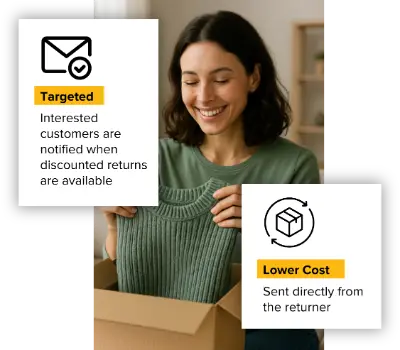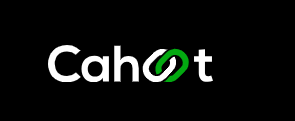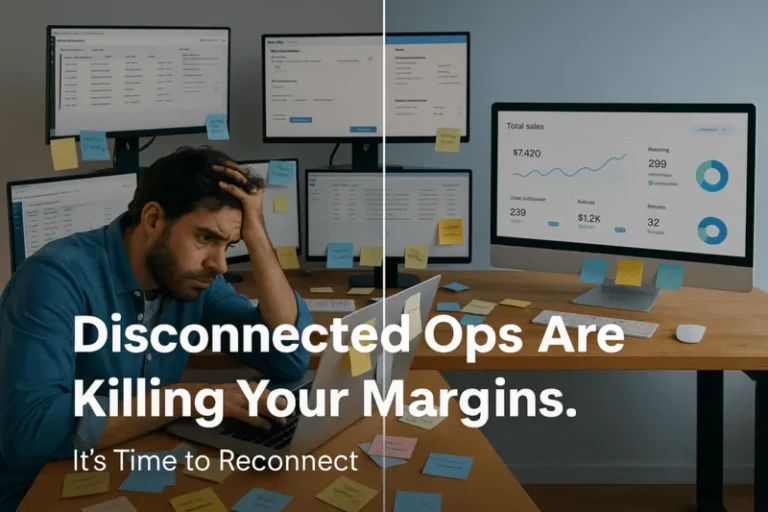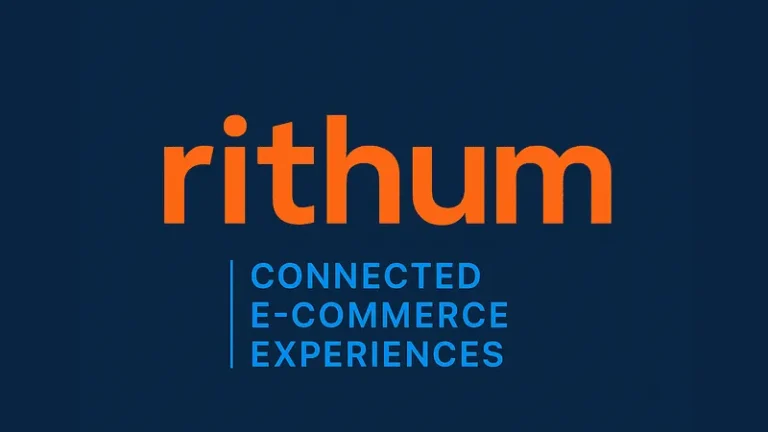How to Optimize Ecommerce Order Fulfillment

Last updated on February 24, 2025

In this article
 29 minutes
29 minutes
- What is Ecommerce Order Fulfillment?
- Building an Ecommerce Fulfillment Model
- Ecommerce Order Fulfillment Service Models
- Ecommerce Fulfillment’s Impact on the Pre-Purchase Buying Journey
- Ecommerce Fulfillment’s Impact on the Post-Purchase Customer Experience
- How to Turn Ecommerce Order Fulfillment Into a Profitable Revenue Driver
- Recap
As an ecommerce merchant, you spend countless hours working to perfect your shopping experience. You put yourself in the customer’s shoes, write compelling copy, take great photos, and relentlessly A/B test your advertising to ensure you’re cutting through the noise. When your customers get to the checkout screen, do they see the free 2-day shipping that they expect? Or does your fulfillment strategy undermine all of your other great work?
On top of that, what happens after the purchase defines your ability to grow profitably. The Harvard Business Review explains, “Acquiring a new customer is anywhere from five to 25 times more expensive than retaining an existing one. Research done by Frederick Reichheld of Bain & Company shows increasing customer retention rates by 5% increases profits by 25% to 95%.”
Many ecommerce businesses face challenges such as supply chain issues and the need for fast shipping, making effective fulfillment strategies crucial for their success. Delivery speed, the tracking experience, notifications, custom packaging, and the returns process all have a huge impact on customer retention rates. The better experience you provide, the more customers you’ll retain. And the more affordably you do it, the more you’ll reap the rewards.
Understanding ecommerce fulfillment cost is crucial as it varies based on factors like order volume, package size, and the types of services offered, including picking, packing, shipping, and storage fees. This guide to ecommerce order fulfillment will give you a comprehensive overview of how you can stop thinking of fulfillment as a cost center and start using it as a way to boost profitable growth. Read on to learn:
What is Ecommerce Order Fulfillment?
We’ll start with the basics– ecommerce order fulfillment is the term for the process of putting an item in a customer’s hands after they order it online.
Generally speaking, the steps are as follows:
- Storage: the merchant keeps inventory in a central location or locations, packaged in a manner to make it easy to pick and put in an individual box.
- Order Processing: the order flows from the online sales channel through to the warehouse in which the product is stored, detailing what was ordered, the delivery address, and the delivery SLA.
- Picking & Packing: personnel in the warehouse locate the item(s), bring them to a packing station, and put them in the appropriate box. They then seal the box and affix the shipping label.
- Carrier Handoff: warehouse personnel hand the package off to a parcel carrier, such as FedEx, UPS, USPS, or a regional carrier.
- Last Mile: the carrier brings the parcel to the customer.
While the last of the steps is almost always performed by a parcel carrier (the rare exception could be for a merchant selling locally on an app like Nextdoor), the first three can be done by the merchant themselves or a third party. That decision, and the myriad options for third-party fulfillment, can be difficult; we’ll get into that later.
Within the broad category of ecommerce order fulfillment, a lot has to go right in order to get the right products to the right customers on-time, every time. Here are the elements of a successful fulfillment strategy:
Slash Your Fulfillment Costs by Up to 30%
Cut shipping expenses by 30% and boost profit with Cahoot's AI-optimized fulfillment services and modern tech —no overheads and no humans required!
I'm Interested in Saving Time and MoneyBuilding an Ecommerce Fulfillment Model
As simple as a garage, or as complex as a million-square-foot automated facility, fulfillment starts with storing inventory. Of course, if you don’t have a product on hand, you can’t put it in a box and ship it to the customer!
Many merchants can not-so-fondly remember stacking products in their bedroom when they first started out, navigating through piles of inventory every time they got up. When you outgrow your humble beginnings and look to either rent a space or outsource your fulfillment, keep these general principles in mind:
- Secure storage: if your product has temperature limits, they need to be met. On top of that, you have to trust your space or provider to minimize shrinkage, or inventory loss. Is the facility set up in such a way that products won’t be damaged on shelves or when they’re moved?
- Efficient organization: can pickers locate ordered items, return them to a packing station, and then get them out the door quickly and repeatedly? Labor is harder to find and more expensive than ever, so the better optimized your space is for picking & packing, the less you’ll have to spend.
- Comprehensive insurance: unfortunately, accidents happen. Whether you’re owning and operating your own space or relying on a third party, make sure that the relevant insurance policy fully covers inventory within the four walls.
- Location, location, location: the location of your fulfillment center can be the difference between turning a profit and losing money. Why? If it’s far away from your customer base, then you’ll have to pay more for shipping – and a few dollars extra per order often wipes out ecommerce margins. Better yet, the best fulfillment outsourcing partners will distribute your inventory nationally, so you always have an item close to the customer, minimizing shipping cost.
While the last of the steps is almost always performed by a parcel carrier (the rare exception could be for a merchant selling locally on an app like Nextdoor), the first three can be done by the merchant themselves or a third party. That decision, and the myriad options for third-party fulfillment, can be difficult – we’ll get into that later.
Within the broad category of ecommerce order fulfillment, a lot has to go right in order to get the right products to the right customers on-time, every time. Effective fulfillment operations are essential to ensure order accuracy and manage peak season pressures.
Here are the elements of a successful fulfillment strategy:
Order Management
Whether your products are only sold on one channel or on many, you of course need to keep track of what is purchased, when, and in what way. In the early days of ecommerce, this was often managed manually by Excel spreadsheets, with employees aggregating orders in a .csv, sending it over to the warehouse, and then reconciling at the end of the day. Fortunately, those days are largely over, and there are a huge number of great OMS tools to choose from.
Your inventory management software, fulfillment software, shipping software, and more will need to integrate with your order management solution so that they quickly and accurately identify what needs to be sent where. Order management, then, will help you track the status of orders throughout the fulfillment process, give updates to the customer, and proactively notify you of issues.
Inventory Management
While order management keeps tabs on the day-to-day of sales and returns, inventory management looks at the broader picture of whether you have enough products stocked in the right places. If you only have one product and fulfill out of one location, inventory management is simple enough. But as you expand to many SKUs and multiple fulfillment locations, then efficient inventory management becomes critical to your ability to operate profitably.
The more efficiently you distribute your inventory, the less inventory you need to keep on hand, and the more capital you can free up for more useful investment.
Just like with order management, there are many great inventory management software options on the market. On top of this, if you outsource fulfillment, your provider should take an active and strategic role in advising your inventory placement. As mentioned above, distributing inventory to multiple locations across the country helps you increase delivery speed and decrease costs – but only if you intelligently pick the right fulfillment center locations and keep them stocked efficiently.
Parcel Shipping
When an order comes in, you’ll know where it needs to ship, and how quickly it needs to get there based on the promise you made to the customer (if any). That’s where the first element of parcel shipping comes in – rate shopping & label printing. There are a ton of options for shipping software that will help you do this, but the best will automatically compare rates across carriers, and then they’ll automatically generate a shipping label. There’s no substitute for shipping software that saves you time and labor for your ecommerce business.
Importantly, the more efficient your label printing, the later you can pick & pack, which allows you to extend cutoff times for your customers. This will increase your results later in the afternoon: your competitors will have pushed back their delivery estimates, while yours stay fast. In this way, an automated shipping software increases your growth as well as saving you money.

Once you have the label printed and affixed to the package, you’ll hand it off to the relevant carrier, and the job of the warehouse is done. Your job, though, isn’t – unfortunately, if the carrier makes a mistake, the vendor is often still blamed for the delivery issue. That’s where another element of a great shipping software comes in – proactive shipping notifications.
The best systems automatically keep tabs on the delivery tracking process, and they’ll notify you when something goes wrong or is delayed. This in turn gives you an opportunity to proactively communicate with the customer, which turns a potentially negative customer experience into a positive customer service interaction. Many businesses opt for outsourced fulfillment to leverage the expertise and infrastructure of third-party logistics providers.
Returns Processing
Unfortunately for online sellers, returns are a near-unavoidable cost of doing business. Shopify reports that a full 20% of online orders are returned, compared to under 10% for brick-and-mortar.
In an ecommerce fulfillment center, a return triggers a process of receiving, inspecting, and potentially processing items back into available inventory. It’s an expensive and time-consuming process, and that’s before considering that not all returned goods come back in a sellable state.
Sellers with 3PLs take many different approaches to returns – some will have the 3PL process returns, while others will have the item sent back to themselves so that they can do the returns management themselves. Streamlining fulfillment processes is essential for managing returns efficiently and maintaining accurate inventory levels.
Ecommerce Order Fulfillment Service Models
Though the basics of ecommerce order fulfillment are the same no matter who executes them, you have a wide variety of options for who actually executes your fulfillment strategy. Each comes with its own pros and cons, and most merchants will swap in between methods, or even use a hybrid approach, to suit the needs of their growing business. Online stores can choose from various fulfillment service models to best suit their operational needs and growth goals.
Use the table below for a quick peek at relative strengths and weaknesses of different fulfillment service models.
|
Service Model
|
Strengths
|
Weaknesses
|
Best Used By
|
|---|---|---|---|
|
“Garage” Fulfillment
|
Easy to start
Low capital requirements |
Demands management’s time
Inefficient shipping |
New sellers with <100 orders per month
|
|
Merchant-Owned Fulfillment Warehouse
|
Complete control over consumer experience
Custom packaging |
Capital intensive
Inefficient shipping (if <4 locations) |
Sellers with highly custom products and unboxing experiences
|
|
Dropshipping
|
Easy to start
Low capital requirements |
Little control over post-purchase experience
Long transit times High competition for products |
New sellers and those testing new product lines
|
|
Marketplace Fulfillment (FBA, WFS)
|
Qualifies you for marketplace badges, boosting results
Easy to start Cost competitive |
Point solution that only works for a single marketplace
Inventory limits block growth Hidden fees increase cost Difficult to launch new products |
Sellers committed to growing on one marketplace
|
|
3PL
|
Many options, so one that suits your needs well can usually be found
Less managerial time investment Negotiated shipping rates can save money |
Can’t affordably power nationwide fast shipping
Difficult to integrate into tech stacks |
Regional sellers that don’t require a nationwide reach
|
|
Distributed Fulfillment Network
|
Covers 99% of US with 2-day shipping at ground rates
Flexibility to handle many use cases Scales with sellers – able to accommodate fast expansion |
Difficulty handling demands for high package customization
Additional complexity in freight and inventory planning |
Multichannel sellers of all sizes that want to turn operations into a growth driver
|
When you’re evaluating your fulfillment approach, the first question shouldn’t be, “how much will this cost?” – instead ask, “how can fulfillment help boost my growth?”. With the rise of modern distributed fulfillment networks.
This prompts the question – how is fulfillment changing from a cost center to a growth driver? Simply put, customers care much more about the post-purchase experience now than they did even a few years ago, so it factors into both their initial purchase decision and their repurchase decision. We’ll dive deep into all the ways in which ecommerce order fulfillment can positively impact the customer experience (and your results) next.
Ecommerce Order Fulfillment
eCommerce is all about the customer, and you spend countless hours designing products, packaging, and marketing to ensure that they’ll have a fantastic experience with your brand both before and after they buy.
Do you think of ecommerce fulfillment in the same way?
A great fulfillment strategy will stand out from an average one both before and after the purchase, delighting the customer and increasing the chance of both the first purchase and repeat purchases down the road. It’s not just the way to get an order to the customer – it’s a way to win the customer. Effective order fulfillment processes are crucial for ensuring that customers receive their orders promptly and accurately.
Ecommerce Fulfillment’s Impact on the Pre-Purchase Buying Journey
First, fulfillment is becoming an ever more critical part of your customer’s buying journey. Ever since Amazon introduced the Prime program with fast & free shipping over a decade ago, customers have grown accustomed to the option of having an item delivered to them in 2 days, for free.
So how does your fulfillment strategy dictate the customer experience before they click “Place Order”?
Looking for a New 3PL? Start with this Free RFP Template
Cut weeks off your selection process. Avoid pitfalls. Get the only 3PL RFP checklist built for ecommerce brands, absolutely free.
Get My Free 3PL RFPWin the Customer’s Attention
Thanks to Amazon, customers expect fast shipping, so of course, they look for it right off the bat. A recent McKinsey survey reveals just how entrenched this customer preference has become: more than 90% of US online shoppers said that they expect free two-to-three-day shipping.
First and foremost, fast and free shipping is close to a prerequisite to growing on Amazon and Walmart. Every type of product on the marketplaces has at least one, and usually, multiple options that qualify for the Prime and TwoDay programs. If your products don’t qualify, you start at a massive deficit for the customer’s attention. On the marketplaces, offers with the key badges receive preferential placement in the Buy Box because the marketplaces know that’s what the customer wants to see. So, they receive more impressions, and those impressions are also more favorable and have a higher click-through rate than similar products without badges. In fact, Amazon estimates that adding a Prime badge to a product boosts its returns by 50%.
What happens on Amazon doesn’t stay on Amazon. Increasingly, customers expect to see fast and free shipping wherever they are online, not just on the major marketplaces. That’s no surprise – nine out of ten shoppers use the marketplaces to comparison shop online, so the vast majority of sales on a DTC website are still subject to competition from products with the Prime badge.
The upshot is that since customers are looking for fast and free shipping outside of the marketplaces, sellers can win their attention by delivering what they want in their copy and imagery. Services like Google Shopping offer merchants the ability to insert “Ships free & fast” copy on their images, increasing their likelihood to be seen and clicked on.
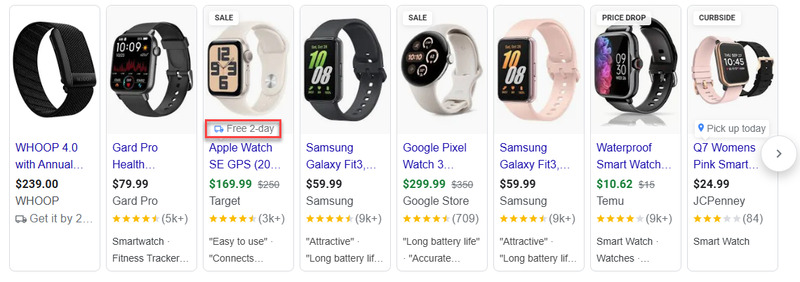
Source: Google search for “smart watch”, 2/12/2024
In the example above, you can see that Target’s listing for an Apple Watch appears on Google Shopping’s carousel with a “Free 2-day” tag, indicating to the online shopper that they have a fast, easy, and free shipping method. In a sign of the escalating competition for fast fulfillment, you can also see that JC Penny offers same-day pickup for a smart watch they sell. This of course requires the customer to get to the store, but it’s also free, and even faster.
The trend has been clear for over a decade, but it bears repeating: customers expect fast and free shipping, and your product is much more likely to get noticed if it touts that clearly.
Set Clear Expectations
Once you have the customer on your product page, it’s not enough to just tell them that their order will come fast – the next level is telling them what day specifically the order will arrive. According to the Baymard Institute, a full 75% of online shoppers said that displaying “Estimated time of arrival” makes them more likely to buy the item.
Customers that need an item by a certain day (say, for a birthday) gain the confidence they need to buy your product from a specific delivery date. Without that certainty, they’re more likely to go elsewhere to make sure their needs are met.
On top of the pre-purchase experience, date-certain delivery also improves the post-purchase experience. If you tell a customer that an item will arrive on a specific day, they won’t experience any “Where Is My Order” anxiety before that day, and they’ll rest easy knowing that it’s on the way. This saves heartache for the customer and a headache for you.
Close the Deal
Offering fast and free shipping isn’t just a way to get the customer onto your Product Display Page – it’s also a critical tool to help convert that consideration into a purchase.
Free shipping is so powerful, it gets customers to increase their order sizes. BigCommerce’s Shipping Report Survey found that 84% of consumers have added an item to their cart in order to meet a minimum order limit for free shipping. Think about that for a second – it doesn’t just improve conversion on the original item that a shopper wanted; it actually improves conversion on a bigger order!
As we covered earlier in this section, customers love fast and free shipping. When they see that they’ll get it throughout the checkout process, they’ll feel better about your store and be more likely to convert.
Smooth Returns
Finally, your ecommerce fulfillment strategy dictates your returns strategy, and a smart returns policy can boost growth without causing an undue hit to profit. From the perspective of customer satisfaction, easy returns are good, no matter what.
According to several surveys and studies, half to two-thirds of customers expect a return window of up to 30 days. If they don’t understand your return policy, or if they see that it’s restrictive, they’re less likely to purchase from you. On top of that, 75% of shoppers expect to be able to return items for free.
Meeting this customer expectation will help you win more purchases from customers that aren’t as familiar with your brand, or customers that are accustomed to always being able to return what they purchase online.
Ecommerce Fulfillment’s Impact on the Post-Purchase Customer Experience
The post-purchase experience is an often-neglected but important aspect of ecommerce for sellers. Fast shipping is important, but the buyer experience does not end when a package is received. Unboxing and, if necessary, returns processes can create very positive or negative consumer impressions that affect brand loyalty, reviews, and ultimately the seller’s bottom line.
Make the Purchase Risk-Free
Fulfillment broadly describes the process of shipping an ordered product to a customer, so it’s no surprise that your fulfillment strategy has a massive impact on the post-purchase customer experience. It can make-or-break your prospects of turning a customer into a loyal repeat purchaser, and so delivering an excellent customer experience is critical to your long-term profitability.
Consider a few statistics about customer preferences for their post-purchase experience. 82% of shoppers say that the returns process influences their purchasing decision, and 60% say that the returns process is “important” when deciding whether to buy online. Or, we can boil this down to one key number: 84% of consumers would not return to a merchant after a single bad shipping experience.
It’s clear that along the entire post-purchase experience, there are many opportunities for brands to improve the customer experience and boost their future returns.
Provide Peace of Mind with Order Tracking
People like certainty in life, and order delivery is no exception to that rule. Customers want to track orders online and on mobile devices, and many want SMS communication throughout the fulfillment process. Fully 88% of customers prefer to receive order updates via text. And the industry has already largely adapted to these demands, with online retailers giving customers a choice of how they’d like to receive shipment updates during checkout.
If your customers are in the dark on where their package is, they’ll be unhappy; doubly so if it’s late. A concise and easy-to-understand tracking page is a must, and a branded one with proactive notifications is even better.
Wow Customers with Custom Packaging and the Unboxing Experience
You don’t get a second chance at a first impression, and your packaging can be a great physical introduction to your brand (or not). Any chef will tell you how much presentation matters to a diner’s overall impression of their meal, and in the same way your packaging and unboxing can improve a customer’s experience with your brand and product.
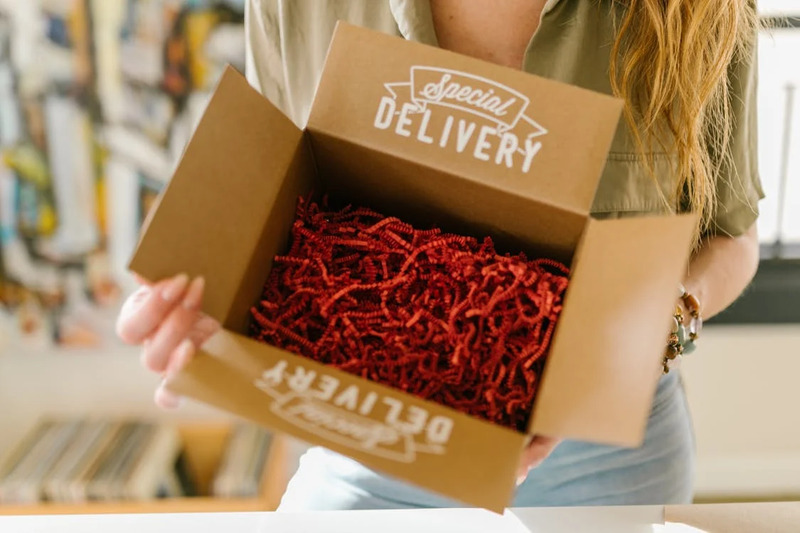
We know that this is just an article about operations, but let’s jump into the science of the question for a moment. A 2013 study published in Psychology & Marketing found the following about how attractive packaging affects the brain:
“First, attractive versus neutral packages evoked more intensive activity changes in brain regions associated with an impulsive system. Second, attractive and unattractive versus neutral packages led to less intensive activity changes in regions associated with a reflective system. Third, attractive packages activated regions associated with reward, whereas unattractive packages activated regions associated with negative emotions.”
In English, this means that a great package increases activity in the parts of people’s brains that deal with rewards. On the other hand, an ugly package increases brain activity in regions that deal with negative emotions.
A package is often quite literally a gift, but even when it’s not – don’t you want your customer to feel like they just received a present? With great packaging and a custom unboxing experience, you can make your order feel like a present – even if the customer ordered it for themself.
Give Customers a Reason to Stick Around
If your fulfillment strategy enables package inserts, then you can significantly upgrade the customer experience with value-add messages and discounts.
The best practice for inserts is to first include a thank you note for the customer, which makes them feel better about supporting a real business with real people. You might be surprised by how far this simple gesture can go in making ecommerce more personal and in building brand loyalty; you’ll get bonus points for including your photo on the note itself.
This simple gesture is ubiquitous in physical retail, but it gets lost in the shuffle of online shopping. Your packaging is an opportunity to make the customer feel good about their order and to build a budding connection with you and your brand.

Another key insert is an explanation of the product itself. Customers, and especially first-time customers, want to get the most out of your product that they can, and so an explainer goes a long way towards them getting that value. You need to pay particular attention to your first-time buyers, as they’re the most critical customers to retain. Providing them with extra love in the form of a quick product explainer can go a long way.
Finally, don’t forget to include a special offer for the customer’s next purchase! People love getting a deal. While a 10% off slip in many of the packages you send seems like a lot at first, keep in mind that acquiring a new customer is 5 to 25 times more expensive than acquiring a new one. Knocking a few percent off the purchase price for a returning customer is far more efficient than advertising to win a new customer, and the more you induce customers to repeat, the more loyal they become, triggering a virtuous cycle.
How to Turn Ecommerce Order Fulfillment Into a Profitable Revenue Driver
Ok, you’re convinced – ecommerce order fulfillment has a huge impact on your customers’ experience, and you want to do better. But right about now, I’m sure that you’re thinking about how expensive everything that we laid out above can be. Expedited shipping alone can add $20 to $30 to each shipment, which would probably put you in the red even without any of the other items.
How can you adopt a great fulfillment strategy to delight customers and boost growth, without breaking the bank?
Offer Fast & Free Shipping Profitably with Distributed Ecommerce Fulfillment
If you want to affordably offer fast and free shipping to increase impressions and your conversion rate, then you need to adopt an Amazon-like distributed fulfillment model in which you strategically place inventory across the country.
Distributed fulfillment feeds two birds with one scone – first, it makes fast shipping much easier by placing inventory closer to customers. And second, because your inventory is close to all customers, you only need ground and economy shipping services to get it to them in 2 days, which actually reduces cost. To reiterate: distributed fulfillment will increase your top-line growth by enabling fast shipping, and at the same time it will increase your profitability by reducing shipping costs.
The chart below shows how much of the United States is covered by 1-day and 2-day shipping with FedEx’s Ground service. As you can see, two locations strategically placed on either coast leaves the entirety of middle America in the cold. Two more locations in the middle of the country will cover Texas and Chicago, and suddenly, you can offer 2-day shipping nationwide!
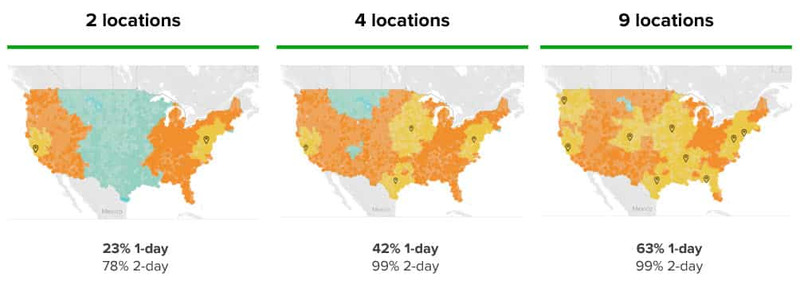
Without this distributed approach with 4+ locations, you’ll severely curtail either your ability to grow or your ability to profit if you’re determined to offer fast & free shipping anyways. If you only offer fast & free shipping around your insufficient number of locations, then you’re essentially giving up on growth in other parts of the country. If you use expedited shipping to cover the whole country, then you’ll either have to eat the costs, wiping out your margin, or charge your customers, which again will curtail growth.
How to Adopt a Distributed Fulfillment Strategy
Amazon FBA and Walmart’s WFS both use a distributed fulfillment strategy, and they’ll work well for merchants that focus on selling small and standard products only on those marketplaces. Those limitations are already restrictive to your growth, and on top of that, Amazon’s inventory score and limits system make it difficult to launch new products via FBA. So they’re good solutions for merchants with heavily marketplace-focused growth strategies and a few proven products, but they fall short for others.
On the other hand, only the largest merchants can even consider opening 4 or 5 of their own locations across the country to operate a merchant-owned distributed network. And even for them, the warehouse and labor markets are extremely challenging. US industrial rents hit a record $8.30/sq ft in December 2024, and Amazon is offering starting pay of up to $22/hr in the hottest markets. Try competing with that and still turning a profit!
Thankfully, the best-in-class modern 3PLs are re-setting the standard for fulfillment outsourcing with models that are designed for distributed ecommerce order fulfillment. At Cahoot, we have a network of over 20 US fulfillment centers, so we strategically distribute every customer’s inventory to the optimal locations. With us, your products will always be delivered quickly, but you’ll never pay more than ground rates. And unlike the marketplace fulfillment solutions, we integrate with all of your sales channels and will customize our approach to your unique needs. Finally, we’ll grow with you – if you’re knocking it out of the park and want to raise the bar, we’ll add even more locations, and cover the whole nation with 1-day shipping! We’re an all-in-one solution for your ecommerce fulfillment needs.
Integrate Fast & Free Shipping into Advertisements
Once you’ve put your strategy for affordable fast shipping in place, you need to get the word out.
First, you’ll want to note that your products are shipping quickly all over your website, the marketplaces, your product display pages, and the checkout process. At each step, customers want to know that they’ll get the product quickly, and they’ll be even happier if you can give them a specific day.
On Amazon, if you’re not using FBA, you’ll need a provider that can qualify for the rigorous Seller Fulfilled Prime program to get the Prime badge. On Walmart, you simply need to prove to them that your orders are delivered quickly, and they’ll add the TwoDay tag. On your DTC site, your relevant app store will have a host of options that will install fast & free shipping tags in the right place all over your site.
It’s not just about your product listings, though. Did you know that you can tout your free & fast shipping right on your Google Ads?

Source: Google Merchant Center Help
Google’s Merchant Center lays out a relatively simple process for getting the coveted tags right on your ads. As long as you can provide them with a data feed that proves that items will indeed be delivered quickly and at no cost to the customer, they’ll put a tag right on your ad’s image, boosting its Click-Through-Rate.
On top of that, some services will provide customers with real-time delivery dates and times right on your website. An app like theirs will help round out the growth benefits of fast & free shipping.
Thread the Needle on the Returns Process
Returns are a thorny issue for ecommerce merchants – as we explained above, customers expect zero-to-low cost, easy returns, yet returns can be incredibly expensive for the merchant. On top of that, they’re getting more common.
Optoro, a returns processor, estimates that a $50 returned item costs an average of $33 to process. At those numbers, a single return likely wipes out the net profit from a few sales, making it that much harder to grow the bottom line. Our friends at Seller Locker’s internal data backs this up, as they show that a 5% return rate results in a 20% loss of net profit.
How do you make returns easy and zero-stress to convert customers, but then keep them from returning items? Let’s take a look at why people return items, so that we can understand how to head off those issues.
Outside of the Apparel category, top reasons for returns are:
- Product issues: The item arrived damaged, quality issues, inaccurate description.
- Operational factors: late delivery, lost packages, wrong item received.
- Customer behavior: gift returns, price sensitivity, customer errors
The first two reasons are closely related to your fulfillment strategy or provider. Can you deliver >99.95% order accuracy? Does your fulfillment provider strategize with you about packaging to reduce transit damage rate? Do you store products securely in the warehouse and barcode scan each action for a clear paper trail?
If you can achieve these targets, then you’ll shrink returns due to damages or inaccurate orders to an absolute minimum. Your warehouse should use barcode scanning to govern actions, which shrinks errors to near-zero. And when errors do happen, your team can quickly see what went wrong and implement corrective measures.
Excellence in reducing returns due to failed expectations starts with your product display page. Clear imagery, product videos, and rich, descriptive text all help customers get familiar with your product before ordering, which in turn reduces the chance that they’ll be unpleasantly surprised upon receiving the item. Then, a package insert that gives the customer a quick primer on the product will help ensure that they don’t misunderstand how to use it.
Scaling Made Easy: Calis Books’ Fulfillment Journey
Learn how Calis Books expanded nationwide, reduced errors, grew sales while cutting headcount, and saved BIG with Cahoot
See Scale JourneyHead Off Questions to Your Customer Service Team
“Where Is My Order” (or WISMO) requests can make up a large portion of an ecommerce seller’s customer service inquiries. Customers shouldn’t have to ask where their order is! You should make it easy for a customer to get that information quickly, and without getting in touch with you.
The most basic approach is ensuring that you email the customer the tracking number that you get from your parcel carrier. The major carriers and many regional ones all have online package tracking, so if you send the customer their number, then they can easily look up where their package is. Just by doing this, you can save labor for your customer service team, reduce your costs, and improve the customer’s experience.
The next level for answering WISMO inquiries is a branded tracking page. Why let the carriers own this part of the customer experience? Many shipping softwares, and some fulfillment providers (like Cahoot) can power branded tracking pages for their customers.
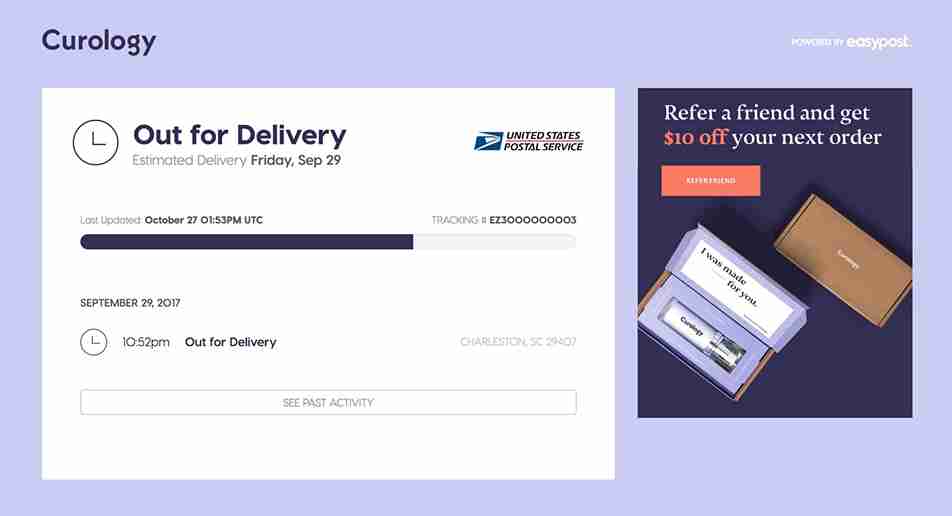
With a branded tracking page, your brand captures the positive feelings from your customer when they get an easy-to-understand update on where their order is in the delivery process. Better yet, you can put advertisements or links to customer resources on the page, which can lead to cross-sells and more loyal customers.
Recap
Whether you’re tackling fulfillment yourself or looking for a partner that can shoulder the load for you, we hope that we’ve provided a roadmap for you to use it as a profit driver, not just another cost center.
Customers have come to expect extremely high standards in certain aspects of fulfillment, like shipping speed and cost, while there’s still room to wow them in others, like custom packaging. If you can use fulfillment to meet and exceed the customer’s expectations, then you’ll reap the rewards in growth. The more efficiently you can do it, the more that growth will contribute to your bottom line.
If you need help with affordable, fast shipping, please don’t hesitate to reach out to our team at Cahoot! Our group of fulfillment experts will take the time to learn your business and your unique needs, discuss fulfillment strategy, and figure out what you can do to boost your profitable growth. Here’s to turning ecommerce order fulfillment into a new source of success!
Turn Returns Into New Revenue
